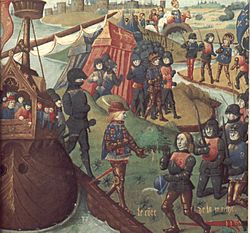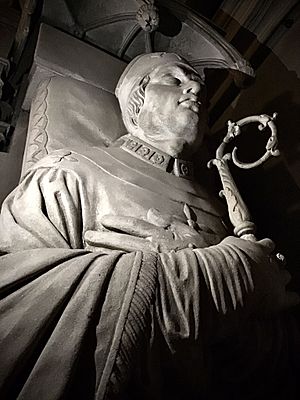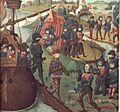Boniface of Savoy (bishop) facts for kids
Quick facts for kids Boniface of Savoy |
|
|---|---|
| Archbishop of Canterbury | |

The site of Lambeth Palace, where Boniface built as an archbishop
|
|
| Appointed | 1 February 1241 |
| Enthroned | 1249 |
| Reign ended | 18 July 1270 |
| Predecessor | Edmund of Abingdon |
| Successor | William Chillenden |
| Orders | |
| Consecration | 15 January 1245 by Pope Innocent IV |
| Personal details | |
| Died | 18 July 1270 Savoy |
| Buried | Hautecombe Abbey in Savoy |
| Parents | Thomas I, Count of Savoy Margaret of Geneva |
| Sainthood | |
| Feast day | 14 July |
| Beatified | 1839 by Pope Gregory XVI |
Boniface of Savoy (around 1207 – 18 July 1270) was an important church leader in the Middle Ages. He served as a Bishop in Savoy and later became the Archbishop of Canterbury in England.
Boniface came from a powerful family. His father was Thomas I, Count of Savoy, a count in the region of Savoy. Many of his relatives were also involved in the church or held important positions. His niece, Eleanor of Provence, was married to King Henry III of England. Another niece married King Louis IX of France.
King Henry III helped Boniface become the Archbishop of Canterbury. Boniface spent a lot of time outside England during his time as archbishop. He faced challenges with other bishops, the king, and even the Pope. However, he successfully paid off the huge debt that the archbishop's office had when he started. Boniface was first on the side of Simon de Montfort, 6th Earl of Leicester during a conflict with King Henry, but later he supported the king. After his death in Savoy, people began to honor him. He was officially recognized as "blessed" (beatified) in 1839.
Contents
Early Life and Family
Boniface was born around 1207 in Savoy. He was the eleventh child of Thomas I, Count of Savoy, and Margaret of Geneva. He had many brothers and sisters. One of his brothers, Amadeus IV, Count of Savoy, became a count like their father. Another brother, Peter II, Count of Savoy, was given the title of Earl of Richmond in England.
Boniface's family was very influential. This helped him get his first church jobs. Some people thought he might have joined a very strict religious group called the Carthusian Order when he was young. However, there is no real proof of this.
Becoming a Church Leader
Boniface started his church career as a Prior in Nantua in 1232. He also became a bishop in Belley, a region in France. When his father passed away, Boniface received a castle as his share of the family's wealth.
Because his niece, Eleanor of Provence, married King Henry III of England, Boniface gained a powerful connection. King Henry tried to make Boniface the Bishop of Winchester, but the local church leaders didn't agree. However, on February 1, 1241, Boniface was chosen to be the Archbishop of Canterbury. This was a very important position in the English church.
The Pope, Innocent IV, confirmed Boniface's appointment in 1243. Boniface didn't come to England until 1244. He was officially made archbishop in 1245 by Pope Innocent IV. But he didn't return to England to take his place at Canterbury Cathedral until 1249. Before returning, he helped arrange another important marriage for his niece, Beatrice of Provence. She married Charles of Anjou, who was the brother of King Louis IX of France.
Archbishop of Canterbury
Some people at the time, like the writer Matthew Paris, thought Boniface was chosen more for his family connections than for his skills. They felt he didn't care much about the spiritual duties of his job. He was also a foreigner, which upset some English people. Boniface spent 14 of his 29 years as archbishop outside of England. He was often busy helping his family's interests in Europe.
However, Boniface did work hard to fix the financial problems of the archbishop's office. When he started, the office was in debt by over 22,000 marks. He managed to pay off all this debt before he died. He did this by getting permission from the Pope to tax the clergy (church officials) for seven years. When some bishops refused to pay, Boniface temporarily removed them from their positions. He also worked to have Edmund of Abingdon recognized as a saint.
Boniface also played a role in choosing other bishops. In 1244, he rejected a candidate for Bishop of Chichester because he thought the person couldn't read or write well. Boniface then chose his own candidate, Richard of Chichester. Even though the king disagreed, the Pope supported Boniface's choice. Boniface also held church meetings to improve the behavior of the clergy. These meetings took place in London in 1257, Merton in 1258, and Lambeth in 1261. During his time, a special court was also set up in the Canterbury archdiocese to handle church matters.
Later Life and Legacy
Boniface left England in November 1268 and never came back. He passed away on July 18, 1270, in Savoy. He was buried with his family at the Cistercian abbey of Hautecombe Abbey in Savoy. In his will, he left money to religious groups in the Canterbury area.
After his death, many people visited Boniface's tomb. When his tomb was opened in 1580, it was said that his body was still perfectly preserved. Sadly, his tomb and statue were destroyed during the French Revolution. His remains were reburied, and a new tomb was built in 1839. He was officially declared "blessed" by Pope Gregory XVI in 1839. His special day of remembrance is July 14.
Even though some people like Matthew Paris didn't always approve of Boniface, modern historians see him as a good and responsible archbishop. Historian D. A. Carpenter said that Boniface "became a respected and reforming archbishop."
Images for kids






